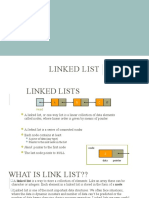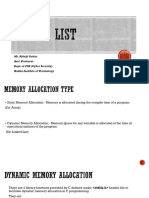0% found this document useful (0 votes)
29 views21 pagesLecture 5 - Circular Linked List
This document covers Circular Linked Lists, detailing their structure and operations such as insertion, deletion, search, and traversal. It includes practical applications in real life, code examples for various operations, and common mistakes to avoid. The document serves as a comprehensive guide for understanding and implementing Circular Linked Lists in programming.
Uploaded by
WafaCopyright
© © All Rights Reserved
We take content rights seriously. If you suspect this is your content, claim it here.
Available Formats
Download as PDF, TXT or read online on Scribd
0% found this document useful (0 votes)
29 views21 pagesLecture 5 - Circular Linked List
This document covers Circular Linked Lists, detailing their structure and operations such as insertion, deletion, search, and traversal. It includes practical applications in real life, code examples for various operations, and common mistakes to avoid. The document serves as a comprehensive guide for understanding and implementing Circular Linked Lists in programming.
Uploaded by
WafaCopyright
© © All Rights Reserved
We take content rights seriously. If you suspect this is your content, claim it here.
Available Formats
Download as PDF, TXT or read online on Scribd
/ 21































































































